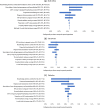Prevalence of undiagnosed HIV among children in South Africa, Côte d'Ivoire and Zimbabwe: a model-based analysis to inform paediatric HIV screening programmes
- PMID: 36519674
- PMCID: PMC9753158
- DOI: 10.1002/jia2.26045
Prevalence of undiagnosed HIV among children in South Africa, Côte d'Ivoire and Zimbabwe: a model-based analysis to inform paediatric HIV screening programmes
Abstract
Introduction: To improve the diagnosis and survival of children living with HIV (CLWH), the World Health Organization recommends testing approaches beyond traditional infant HIV testing programmes. Information about undiagnosed HIV prevalence among children of varying ages in the general population is needed to guide innovative national/subnational case-finding and testing approaches.
Methods: We used the Cost-Effectiveness of Preventing AIDS Complications (CEPAC)-Pediatric model to estimate the prevalence of undiagnosed HIV in 2-, 5- and 10-year-old children in South Africa, Côte d'Ivoire and Zimbabwe in 2018. We simulated cohorts of children born in 2008 (10-year-olds), 2013 (5-year-olds) and 2016 (2-year-olds). Country-/year-specific inputs for pregnant/breastfeeding women included: HIV prevalence (4.2-32.3%), HIV incidence (0.03-0.24%/month), knowledge of HIV status (27-89%) and antiretroviral drug coverage (36-95%). Paediatric inputs included early infant testing coverage (6-95%) and breastfeeding duration (0-20 months). We projected the proportion of surviving CLWH in whom HIV remained undiagnosed and the undiagnosed HIV prevalence among surviving children of each age in the general population. For children born in 2016, we projected survival and diagnosis of all CLWH through 2026. We conducted sensitivity analyses on model parameters.
Results: In 2018, the projected proportion of surviving CLWH whose HIV remained undiagnosed in South Africa/Côte d'Ivoire/Zimbabwe was 44.2%/55.8%/52.9% among 2-year-old CLWH; 29.0%/37.8%/33.2% among 5-year-old CLWH; and 18.3%/25.4%/23.1% among 10-year-old CLWH. Projected general population undiagnosed HIV prevalence in South Africa/Côte d'Ivoire/Zimbabwe was 0.44%/0.32%/0.68% among 2-year-olds; 0.25%/0.17%/0.41% among 5-year-olds; and 0.24%/0.14%/0.38% among 10-year-olds. Among all CLWH born in 2016, 50-54% were projected to die without HIV diagnosis (and subsequently without treatment) within 10 years after birth; 80-85% of these deaths occurred in the first 2 years.
Conclusions: Projected population-level undiagnosed HIV prevalence is low and sharply decreases after age 2, with more CLWH dying than being diagnosed. Despite low undiagnosed prevalence in the general population of older children, we project that a large proportion of CLWH remain undiagnosed, suggesting that innovative strategies targeting untested children of all ages outside of health facility settings should be prioritized. Programmes could consider routine testing of the general population of children below 2 in all settings and children of all ages in high-prevalence settings.
Keywords: Africa < region; HIV care continuum; modelling; paediatrics; testing; vertical transmission.
© 2022 The Authors. Journal of the International AIDS Society published by John Wiley & Sons Ltd on behalf of the International AIDS Society.
Conflict of interest statement
The authors have no competing interests to disclose.
Figures



References
-
- UNAIDS . New HIV infections ‐ children (0–14) [Internet]. AIDSInfo. [cited 2022 Jul 25]. Available from: https://aidsinfo.unaids.org/
-
- UNAIDS . AIDS‐related deaths ‐ children (0–14) [Internet]. AIDSInfo. [cited 2022 Jul 24]. Available from: https://aidsinfo.unaids.org/
-
- World Health Organization . HIV: key facts [Internet]. 2022 [cited 2022 Jul 23]. Available from: https://www.who.int/news‐room/fact‐sheets/detail/hiv‐aids#:~:text=Global...
-
- World Health Organization . Consolidated guidelines on HIV prevention, testing, treatment, service delivery and monitoring: recommendations for a public health approach [Internet]. 2021 [cited 2022 Jun 23]. Available from: https://www.who.int/publications/i/item/9789240031593 - PubMed
Publication types
MeSH terms
Grants and funding
LinkOut - more resources
Full Text Sources
Medical

